
12.12. ANOTHER VERSION OF PRODUCT MEASURES 329
It follows s′n is an increasing sequence of F measurable nonnegative simple functions.Since each s′n ≥ sn, it follows that if h(ω) = limn→∞ s′n (ω) ,then h(ω) ≥ f (ω) . Also ifh(ω)> f (ω) , then ω ∈∪nMn≡M′, a set of F having measure zero. By Theorem 12.11.1,there exists M ⊇M′ such that M ∈F and µ (M) = 0. It follows h = f off M. This provesthe theorem.
12.12 Another Version Of Product Measures12.12.1 General TheoryGiven two finite measure spaces, (X ,F ,µ) and (Y,S ,ν) , there is a way to define a σ
algebra of subsets of X ×Y , denoted by F ×S and a measure, denoted by µ×ν definedon this σ algebra such that
µ×ν (A×B) = µ (A)ν (B)
whenever A ∈F and B ∈S . This is naturally related to the concept of iterated integralssimilar to what is used in calculus to evaluate a multiple integral. The approach is based onsomething called a π system, [36].
Definition 12.12.1 Let (X ,F ,µ) and (Y,S ,ν) be two measure spaces. A measurablerectangle is a set of the form A×B where A ∈F and B ∈S .
Definition 12.12.2 Let Ω be a set and let K be a collection of subsets of Ω. Then K iscalled a π system if /0,Ω ∈K and whenever A,B ∈K , it follows A∩B ∈K .
Obviously an example of a π system is the set of measurable rectangles because
A×B∩A′×B′ =(A∩A′
)×(B∩B′
).
The following is the fundamental lemma which shows these π systems are useful. Thislemma is due to Dynkin.
Lemma 12.12.3 Let K be a π system of subsets of Ω, a set. Also let G be a collection ofsubsets of Ω which satisfies the following three properties.
1. K ⊆ G
2. If A ∈ G , then AC ∈ G
3. If {Ai}∞
i=1 is a sequence of disjoint sets from G then ∪∞i=1Ai ∈ G .
Then G ⊇ σ (K ) , where σ (K ) is the smallest σ algebra which contains K .
Proof: First note that ifH ≡ {G : 1 - 3 all hold}
then ∩H yields a collection of sets which also satisfies 1 - 3. Therefore, I will assume inthe argument that G is the smallest collection satisfying 1 - 3. Let A ∈K and define
GA ≡ {B ∈ G : A∩B ∈ G } .